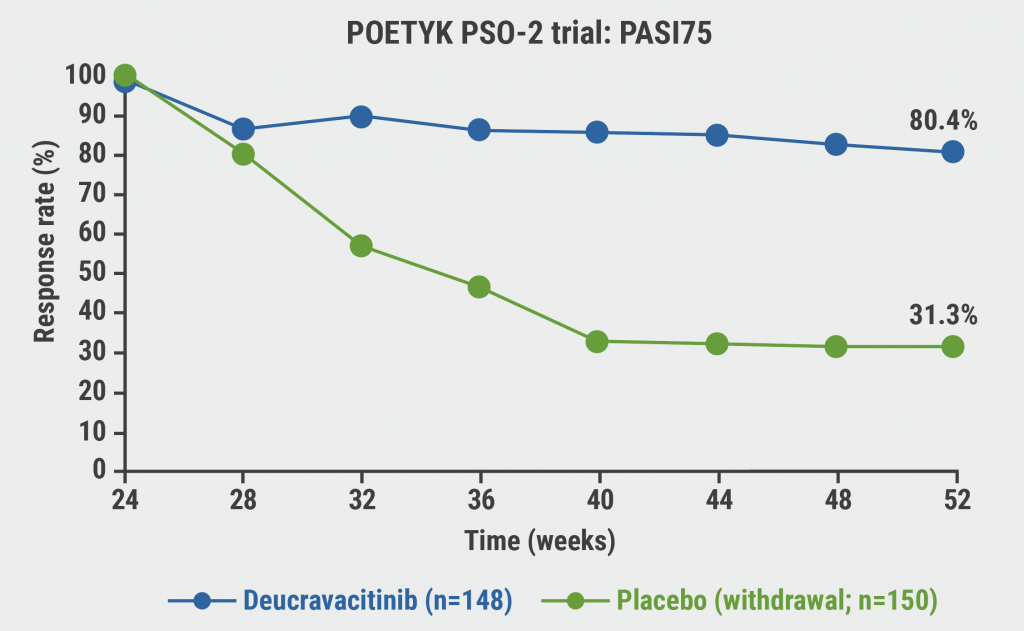Both IL-4 and IL-13 are pivotal cytokines involved in the pathogenesis of AD and other allergic diseases. Despite effective approved treatment options for AD, some patients still have an inadequate response. Safety concerns, in particular conjunctivitis, also exist for these therapies.
Eblasakimab is a first-in-class molecule with a novel mechanism of action. The drug selectively targets the IL-13 receptor (R) α1 and blocks both IL-4 and IL-13 signalling through the type 2 receptor. Selective targeting of the type 2 receptor (and sparing type 1 receptor signalling) offers the potential to avoid unwanted effects. “Dupilumab blocks all of IL-4 while this drug blocks only part of IL-4 but all IL-13,” Prof. Andrew Blauvelt (Oregon Medical Research Center, OR, USA) explained the difference (see Figure).
Figure: Contrary to other IL-4/IL-13 blockers, eblasakimab spares part of the IL-4 signalling, which might lead to better tolerability [1]

In this first proof-of-concept study, 24 adults were enrolled with moderate or severe AD of at least 3 years' duration, Eczema Area and Severity (EASI) score ≥16, Investigator Global Assessment (IGA) score ≥3, and at least 10% body surface area. During a dose-escalation study, participants were randomised 1:1:1:1 to placebo or 1 of 3 weekly doses of eblasakimab (200, 400, or 600 mg). Subsequently, an additional 27 patients were randomised 2:1 to the highest dose of eblasakimab or placebo. The primary endpoint was the mean percentage improvement in EASI at week 8.
At week 8, the EASI score was reduced by 61% in the highest eblasakimab dose, by 60% in the 400 mg dose, and by 50% in the 200 mg dose compared with 32% with placebo (P=0.023). A treatment effect was already seen within the first week. Analysis of the key secondary endpoints of EASI50 showed 8-week response rates of 71% and 77% with the 400 mg dose and 600 mg dose of the antibody versus 38% with placebo (P=0.016). EASI70 was achieved by 50% of participants treated with the 600 mg dose of eblasakimab and 57% with the 400 mg dose at this time (P=0.018 vs placebo). The agent also had a distinct antipruritic effect: the itch score decreased by 37% with the highest dose of the antibody compared with 16% with placebo (P=0.032). “We see very nice drops in percentage EASI and maybe some plateauing at the 400 mg dose. And you see, as expected, a nice drop in the itch score,” Prof. Blauvelt commented on the results.
The rate of moderate-to-severe adverse events (AEs) was comparable between the 600 mg dose of the antibody and placebo and AEs leading to discontinuation occurred more often with placebo. There was 1 serious AE (abdominal pain) in the 400 mg eblasakimab group that was considered unrelated to treatment. Reassuringly, conjunctivitis occurred only in 3 eblasakimab-treated patients, 1 of them in the 600 mg group. “It is a small number [of participants] and only 8 weeks of therapy, but it seems rare,” Prof. Blauvelt said.
"This proof-of-concept, early-phase, first-in-human study, has shown nice efficacy, in my view”, Prof. Blauvelt concluded. As a result of these promising results, a phase 2b trial including more patients is now underway.
- Blauvelt A. Eblasakimab, a human IL-13 Rα1 monoclonal antibody, in adult patients with moderate-to-severe dermatitis: a randomized double-blind, placebo-controlled proof-of-concept study. S026, AAD 2022 Annual Meeting, 25–29 March, Boston, MA, USA.
Copyright ©2022 Medicom Medical Publishers
Posted on
Previous Article
« New insights into psoriasis comorbidity Next Article
Lebrikizumab treatment leads to encouraging outcomes in multiple traits of AD »
« New insights into psoriasis comorbidity Next Article
Lebrikizumab treatment leads to encouraging outcomes in multiple traits of AD »
Table of Contents: AAD 2022
Featured articles
Letter from the Editor
Lebrikizumab treatment leads to encouraging outcomes in multiple traits of AD
New Developments and Unmet Needs in Dermatology
Light at the end of the tunnel for vitiligo therapy
Intestinal microbe-preparation: Modest activity but safe for mild psoriasis
Alopecia areata: 1-year baricitinib treatment increases success
New anticholinergic preparation is effective and tolerable in hyperhidrosis
What’s Hot in Rare Diseases
Add-on apremilast may improve recalcitrant dermatomyositis
Could dupilumab put an end to the therapeutic draught in prurigo nodularis?
Fungal skin infections in children: A diagnosis to keep in mind
Innovative gel speeds up clearance of molluscum contagiosum lesions
JAK inhibition offers promising treatment prospects for uncommon dermatoses
JAK inhibitors may offer a new horizon in the treatment of sarcoidosis
Psoriasis: State of the Art
New insights into psoriasis comorbidity
Long-term psoriasis treatment with bimekizumab results in maintained efficacy
Novel developments in topical psoriasis therapy
Atopic Dermatitis: Novel Agents Enter the Stage
JAK inhibitors in AD: Setting the efficacy bar even higher
Lebrikizumab treatment leads to encouraging outcomes in multiple traits of AD
Novel IL-4/IL-13 blocker shows high efficacy with only modest conjunctivitis signal
Posters
Inpatient dermatologic therapy is linked to lower mortality and readmission rates
AD treatment during the pandemic: dupilumab does not raise COVID-19 infection risk
Upadacitinib: Fast and more pronounced skin improvement in AD patients
Dermatology diseases need the highest doses of biologics
Related Articles

August 26, 2022
Systemic treatment for psoriasis: what is on the horizon?
June 21, 2019
ABP501 biosimilar for adalimumab: What you need to know
© 2024 Medicom Medical Publishers. All rights reserved. Terms and Conditions | Privacy Policy

